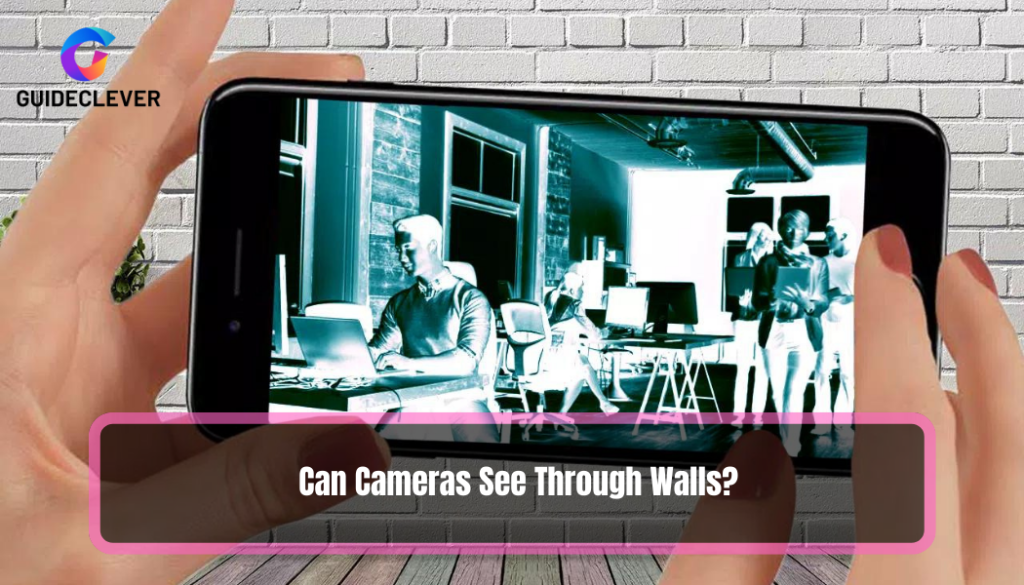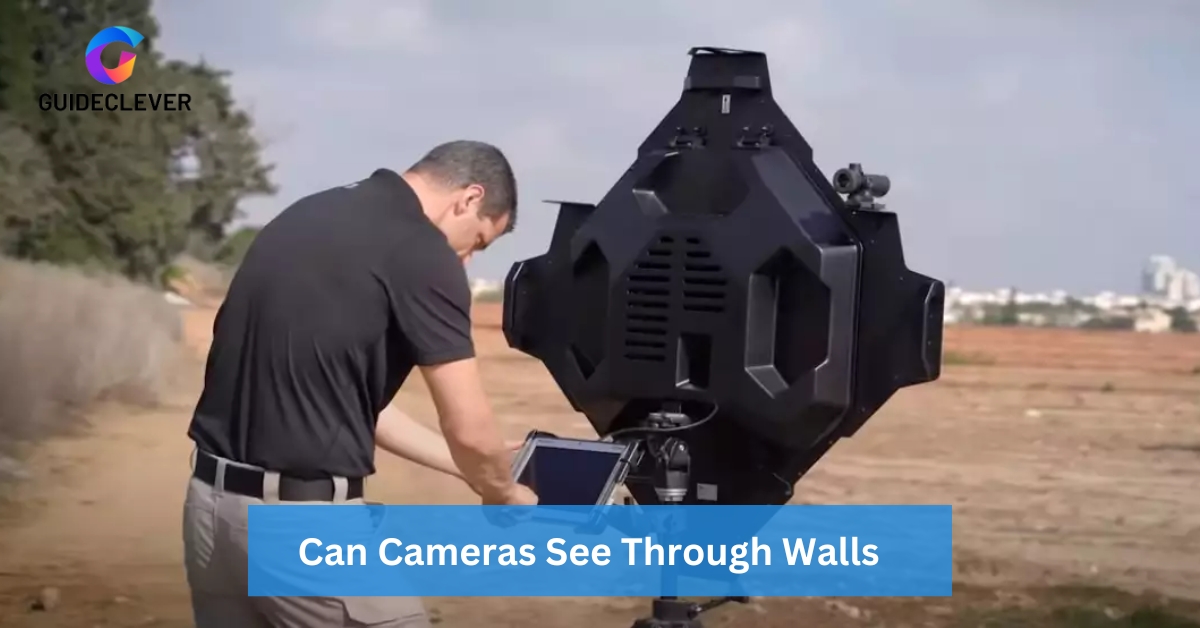In our modern world, where technology keeps pushing the limits, we wonder. Can cameras see through walls?” emerges as a captivating and enigmatic inquiry. The concept of looking through walls. It has inspired many science fiction stories and different fields.
Let’s explore cameras that can see things that seem supernatural. Discover the complex science and advanced technologies. That reveals hidden images and information behind walls. Learn about the exciting possibilities and limitations of this intriguing pursuit.
Get ready, because we’re going on a journey into the world of camera technology. The line between imagination and reality is always getting blurry.
Contents
Understanding the Basics of Camera potential to see through walls
Before we can discuss cameras’ potential to see through walls, let’s start with the basics. Cameras are incredible devices that have been a part of our lives for well over a century.
From simple box cameras to the amazing digital devices we carry, they have evolved a lot. To understand how cameras see through walls, we need to know their basic principles.
1. The Camera Obscura and Early Photography
Cameras have been around since the camera obscura. It was a simple device that projected outside images onto a surface in a dark room. This concept laid the foundation for photography as we know it.
- Camera Obscura: The camera obscura was the precursor to the modern camera. The manipulation of light captures an image, showing a basic principle.
2. The Role of Light in Photography
At the heart of all cameras is the manipulation of light. The basic idea of cameras, from ancient to modern, is to capture images using lenses.
- Lens and Aperture: In a traditional camera. light enters through a lens and passes through an aperture (an adjustable opening). This aperture controls the amount of light that reaches the photosensitive surface.
- Exposure: The duration for which the photosensitive surface (often a photosensitive film or digital sensor) is exposed to light determines the image’s exposure. Longer exposures capture more light, resulting in brighter images.
- Shutter: The camera’s shutter mechanism controls the exposure time. It opens to let in light and then closes to stop exposure.
- ISO Sensitivity: The photosensitive surface’s sensitivity to light is measured by ISO. Higher ISO values increase sensitivity, improving performance in low-light conditions.
3. Evolution of Camera Technology
Over time, cameras have evolved from simple film-based devices to complex digital systems. Digital technology revolutionized photography, making it easier and more versatile than ever.
- Digital Sensors: Instead of using film. modern cameras use digital sensors to capture images. The sensors change light to electrical signals. These signals are used to make digital images.
- Image Processing: Digital cameras often include onboard processors and software. It can enhance and manipulate images, providing photographers with unprecedented creative control.
- Connectivity: Many modern cameras come equipped with wireless connectivity options. That allows users to instantly share their photos and videos with the world.
It's important to understand the basic principles of traditional cameras. When we learn about advanced technologies and cameras that can see through walls. Cameras have improved, but their main purpose is still to capture light and create images. But, to see through walls, we need special cameras and the electromagnetic spectrum. That's where the real intrigue begins.
Can Cameras See Through Walls?

Cameras, in the conventional sense, cannot see through solid walls. Cameras capture images using light or radiation. However, walls block the radiation from passing through. If there is a wall between the camera and the object, the camera cannot see through it.
But some technologies and methods can detect objects or activities on the other side of a wall. These are specialized and different from a regular camera.
- Thermal Imaging: Some thermal cameras can detect heat signatures emitted by objects or people on the other side of a wall. However, thermal imaging doesn’t show detailed images. It mainly detects heat sources.
- Through-Wall Radar: Specialized radar systems can be used to detect motion or objects through walls. These systems send out radio waves that can go through some walls and bounce off objects or people. Law enforcement and military applications sometimes use this technology.
- Ultrasound: Ultrasonic imaging can sometimes be used to detect objects or movements behind walls, but it is not very effective for detailed imaging.
- X-ray and Other Advanced Imaging: In some medical and industrial contexts, X-ray or other advanced imaging technologies can be used to see through certain types of walls or materials. However, this requires specialized equipment and controlled conditions.
When trying to "see" through walls, the type of wall and its thickness can limit you. It's also important to consider the technology being used. Many of these methods have privacy and legal limitations. They could invade people's privacy without regulation.
The Science Behind Cameras Seeing Through Walls
To understand how cameras can see through walls. We need to study the electromagnetic spectrum. This spectrum includes many types of radiation, each with its own special properties. Cameras can see through walls because of the wavelengths they use.
1. The Electromagnetic Spectrum
The electromagnetic spectrum is a range of waves. These waves travel through space and carry energy. It encompasses various types of radiation, including:
- Visible Light: This is the part of the spectrum that our eyes can perceive. The colors range from red to violet. The wavelengths are relatively short.
- Infrared (IR): Beyond the visible spectrum, we find infrared radiation. IR radiation has longer wavelengths than visible light. It is often linked with heat.
- Microwaves: Moving further along the spectrum, we encounter microwaves. Microwaves have longer wavelengths. They are used in technologies like microwave ovens and communication devices.
- Radio Waves: At the lower end of the spectrum are radio waves, which have the longest wavelengths. These waves are used for many things. like broadcasting radio and TV signals and wireless communication.
2. Penetrating Materials with Electromagnetic Waves
The ability of electromagnetic waves to penetrate materials depends on their wavelength. To put it simply, shorter waves have more power and can pass through solid things better.
- X-rays: X-rays have very short wavelengths and high energy levels, making them capable of penetrating dense materials like human tissue and some types of metals. This property makes them valuable in medical imaging and airport security.
- Terahertz Waves: Terahertz waves, with wavelengths between microwaves and infrared light, can penetrate clothing and some biological tissues. This characteristic makes them useful for security scanning and medical diagnostics.
- Microwaves: Microwaves, commonly used for communication and cooking, can penetrate various materials, depending on their frequency. They are particularly useful for imaging some materials, including substances used in construction.
3. Specialized Cameras and Imaging Systems
Special cameras can see through walls and other materials using specialized imaging systems. These systems use certain parts of the electromagnetic spectrum. like terahertz or microwave radiation. They create images that show hidden objects.
- Terahertz Imaging: Terahertz cameras and sensors can capture images using terahertz waves. They have applications in security scanning, pharmaceutical quality control, and even art preservation.
- Microwave Imaging: Microwave imaging technology, often used in construction and geological surveys, can detect variations in material density and composition, allowing it to see through certain walls and objects.
- X-ray Imaging: X-ray cameras and scanners, like those found in medical facilities and at airport security checkpoints, utilize X-rays to create detailed images of objects and materials.
To understand how cameras see through walls. we must first learn about the electromagnetic spectrum. This spectrum includes different wavelengths that interact with materials. As we discover different technologies. you'll learn about imaging systems and what they can do.
Additional Resources
For those interested in exploring this topic further, here are some additional resources:
- Can Any Camera See Infrared Light
- Should Security Cameras be Visible
- Two Main Settings For A Camera
- How To Troubleshoot Security Camera
Conclusion
We are ending our exploration of whether cameras can see through walls. It combines science, technology, and curiosity. We learned about the electromagnetic spectrum, camera technology, and specialized imaging systems. Cameras can see through barriers using waves like terahertz, microwaves, or X-rays.
But, this journey has also taught us the importance of using technology responsibly. It is crucial to consider ethics and have strong regulations in a world that is always changing. Privacy and security are at risk. As we research camera upgrades. It is important to protect people’s rights and well-being.
Cameras can see through walls, revealing human curiosity and the thirst for knowledge. Technology is advancing, giving us many possibilities and responsibilities. This reminds us: Can cameras see through walls?” are as complex and dynamic as the world we seek to explore. Thank you for joining us on this enlightening journey. May your future be filled with wonder and wisdom. See it through the lens of innovation.



1 thought on “Can Cameras See Through Walls- Unveiling the Unseen!”